Reconstruction as an Opportunity to Reduce Risk? Physical Changes Post-Wildfire in Chilean Case Studies
Abstract
1. Introduction
2. Materials and Methods
2.1. Selection of Cases
Governance Context of the Case Studies
- On-Site Construction Subsidy (CSP)
- Construction on New Land Subsidy (CNT)
- Subsidy for the Acquisition of Already Built Housing (AVC)
- Material Bank Subsidy (BM)
2.2. Data Collection
2.3. Data Analysis
- (a)
- Avoid wildfire exposure, by directing new settlements to safe areas and restricting development in high-risk areas, particularly around sensitive infrastructure. This also includes relocating people and assets from zones prone to wildfires.
- (b)
- Reduce wildfire exposure, by clearing or modifying vegetation near buildings to create a buffer zone.
- (c)
- Increase resistance to wildfires, improving construction, landscape, and infrastructure to better withstand a wildfire attack.
- (d)
- Improve response to wildfires, by facilitating the response of emergency services to answer with better access for fire trucks and water supplies, and providing multiple escape routes for residents.
- (e)
- Facilitate early recovery, by building emergency dwellings for affected families and other temporary facilities for the initial reconstruction process.
- (f)
- Reduce other risks, focused on slope stabilization and retaining walls.
- (g)
- Improving other liveability aspects, by building facilities for communities, including public squares, community centres, sports centres, and sanitary improvements.
- (h)
- Restore preexisting conditions, to rebuild housing and facilities without additional improvements beyond the minimum standard.
3. Results
3.1. Valparaiso 2014 Case Study
3.2. Santa Olga 2017 Case Study
3.3. Castro 2021 Case Study
3.4. Punta Lavapie 2023 Case Study
4. Discussion
5. Conclusions
Author Contributions
Funding
Institutional Review Board Statement
Informed Consent Statement
Data Availability Statement
Conflicts of Interest
Abbreviations
| AVC | Subsidy for the Acquisition of Already Built Housing |
| BM | Bank Material Subsidy |
| CNT | Construction on New Land Subsidy |
| CONAF | former National Forestry Corporation |
| CSP | On-Site Construction Subsidy |
| DRR | Disaster Risk Reduction |
| FIBE | Basic Emergency Form |
| MINVU | Ministry of Housing and Urbanism |
| MOP | Ministry of Public Works |
| ONEMI | Office of National Emergency of the Interior Ministry |
| ONGs | Non-Governmental Organizations |
| SENAPRED | National Disaster Prevention and Response Service |
| SEREMI | Regional Ministerial Secretariat |
| SERNAFOR | National Forestry Service |
| SERVIU | Regional Housing and Urbanization Services |
| WUI | Wildfire-Urban Interface |
| CLP | Chilean Pesos |
| UF | Chilean inflation-adjusted unit |
Appendix A
Appendix A.1. Valparaiso 2014
| Origin | Entity | Document Name | Date | |
| 1 | Official document | MINVU | Reporte Plan de Reconstrucción, Incendio Valparaiso 12 abril 2014 | 30 September 2018 |
| 2 | Official document | MINVU | Reporte Plan de Reconstrucción, Incendio Valparaiso 12 abril 2014 | 31 July 2019 |
| 3 | Official document | MINVU | Reporte Plan de Reconstrucción, Incendio Valparaiso 12 abril 2014 | 13 December 2020 |
| 4 | Official document | MINVU | Reporte Plan de Reconstrucción, Incendio Valparaiso 12 abril 2014 | 15 September 2021 |
| 5 | Official document | MINVU | Reporte Plan de Reconstrucción, Incendio Valparaiso 12 abril 2014 | 31 December 2022 |
| 6 | Official document | MINVU | Reporte Plan de Reconstrucción, Incendio Valparaiso 12 abril 2014 | 28 February 2023 |
| 7 | Official document | MINVU | Resolución Exenta 3052. Llamado especial para el otorgamiento de subsidios habitacionales regulados por los Decretos N° 1 y 49, ambos de 2011, para los damnificados por el incendio del mes de abril de 2014 que afectó la comuna de Valparaiso. Fija el monto de recursos que se destinarán para el Subsidio Directo | 2014 |
| 8 | Official document | MINVU | Resolución Exenta 555. Llama a postulación en condiciones especiales para el otorgamiento de subsidios habitacionales del fondo solidario de elección de vivienda, regulado por el decreto N° 49, de 2011, en la alternativa de postulación colectiva con Proyecto Habitacional, tipología de construcción en nuevos terrenos, para los damnificados por el incendio del mes de abril de 2014 que afectó a la comuna de Valparaiso | 2015 |
| 9 | Official document | MINVU | MINVU. Subsidios del programa habitacional del fondo solidario de elección de vivienda, modalidades construcción en Sitio Propio y Densificación Predial, conforme al Artículo 27 del DS N°49 (V. Y U.) de 2021, cuyo texto fue reemplazado por el Artículo Primero del DS N°105 (V. Y U.) de 2014 a damnificados de la comuna de Valparaiso, en la region de Valparaiso–Resolución Exenta 10236. 2015. | 2016 |
| 10 | Official document | MINVU | MINVU. Subsidios del programa habitacional de vivienda, modalidad construcción en Sitio Propio y Densificación Predial, conforme al Artículo 27 del D.S. N°49, (V. Y U.) de 2011, cuyo texto fue reemplazado por el Artículo primero del D.S. N°105, (V. Y U.) de 2014, a damnificados de la comuna de Valparaiso, en la region de Valparaiso–Resolución Exenta N° 03488. | 2016 |
| 11 | Official document | MINVU | Resolución Exenta 000410. Subsidios habitacionales adicionales, conforme al Artículo 27 Familias pertenecientes al proyecto “Condominio Social Placilla” de la comuna de Valparaiso, region de Valparaiso | 2018 |
| 12 | Official document | Observatorio | Reconstrucción Gran Incendio de Valparaiso Reporte 1 | 2015 |
| 13 | Official document | Senado | Informe de la Comisión Especial sobre catástrofe por incendio en Valparaiso | 2015 |
| 14 | Official document | SERVIU region Valparaiso | LP 17/2017. Programa Conservación conectividad de los barrios afectados por el incendio 2014, Conservación calle Lircay, Cerro La Cruz, comuna Valparaiso–Resolución Exenta N°155 1779 | 2017 |
| 15 | Official document | SERVIU region Valparaiso | LP 75/2017. Programa conservación de muros para estabilizar terrenos en zona de incendio Valparaiso, Construcción Obras de Mitigación muros de terceros, 3 roles, Cerro La Cruz y Las Cañas, comuna de Valparaiso–Resolución Exenta N°155 2567. | 2017 |
| 16 | Official document | SERVIU region Valparaiso | LP 75/2017. Programa “Conservación conectividad de los cerros afectados por el incendio 2014, conservación pasaje Bombero Manfatti, Cerro La Cruz, comuna de Valparaiso–Resolución Exenta N°155 3585. 2017, Resolución Exenta N°155 3585. | 2017 |
| 17 | Official document | SERVIU region Valparaiso | TD 64/2016. Programa de conservación muros para estabilizar terrenos en zona incendio de Valparaiso, Construcción obras de mitigación entre privados, ROLES N°5154-002, N°5154-005, N°5160-296 Y N°5160-379 Cerro Las Cañas, comuna Valparaiso–Resolución Exenta N°155 2641. | 2016 |
| 18 | Official document | SERVIU region Valparaiso | LP 08/2017. Programa vialidad urbana, proyecto mejoramiento Avenida Alemania, Etapa 1 comunidad de Valparaiso–Resolución Exenta N°155 0041. | 2017 |
| 19 | Official document | SERVIU region Valparaiso | LP 132/2016. Programa recuperación de barrios, proyectos zona seguras y señaléticas, Plaza El Recuerdo y Estatua La Virgen, Cerro Merced, comuna Valparaiso–Resolución Exenta N°155 2624 | 2017 |
| 20 | Official document | SERVIU region Valparaiso | LP 133/2016. Programa recuperación de barrios, red de puntos seguros, subcomisaria Las Cañas, comuna de Valparaiso, red de puntos seguros, sede junta de vecinos Santa Rosa del Pajonal, Cerro Las Cañas, comuna Valparaiso–Resolución Exenta N°155 3009. | 2017 |
| 21 | Official document | SERVIU region Valparaiso | LP 135/2017. Programa recuperación de barrios, proyecto mejoramiento integral espacio deportivo y de habilitación infantiles, consolidación circuito Plazas calle Trípoli; consolidación mirador Trípoli con Cariolán, Cerro El Litre, comuna de Valparaiso–Resolución Exenta N°155 6231 | 2017 |
| 22 | Official document | SERVIU region Valparaiso | LP 16/2017 Programa vialidad urbana, proyecto mejoramiento calle El Vergel, comuna de Valparaiso–Resolución Exenta N°155 7095. | 2017 |
| 23 | Official document | SERVIU region Valparaiso | LP 163/2017. Programa conservación de muros para estabilizar terrenos en zona incendio Valparaiso, mitigación muros de terceros, varios roles, calle Los Canelos y otros, varios cerros, comuna de Valparaiso–Resolución Exenta N°155 5591. | 2017 |
| 24 | Official document | SERVIU region Valparaiso | LP 175/2017. Programa conservación calle La Fontaine etapa I, entre Santa Teresa y Lambecho, Cerro El Litre, comuna de Valparaiso–Resolución Exenta N°155 7059 | 2017 |
| 25 | Official document | SERVIU region Valparaiso | LP 193/2017. Programa conservación de muros para estabilizar terrenos en zona incendio, construcción obras de mitigación varios roles calle Azorín y otros, carro La Cruz, Las Cañas y Merced, comuna de Valparaiso–Resolución Exenta N°155 7064. | 2017 |
| 26 | Official document | SERVIU region Valparaiso | LP 194/2017. Conservación de muros para estabilizar terrenos, zona incendio Valparaiso, construcción de obras de mitigación entre privados, 9 roles, cerros Las Cañas, Merced y La Cruz, comuna de Valparaiso–Resolución exenta N°155 5753. | 2017 |
| 27 | Official document | SERVIU region Valparaiso | LP 199/2017. Programa conservación de muros para estabilizar terrenos en zona incendio, proyecto de muro contención en pasaje Rembrandt, Cerro El Litre, comuna de Valparaiso–Resolución Exenta N°5751. | 2017 |
| 28 | Official document | SERVIU region Valparaiso | LP 211/2017. Programa conservación de muros para estabilizar terrenos en zona incendio Valparaiso, construcción obras de mitigación entre privados ROL N°5160-078, calle Los Alerces, cerro Las Cañas, comuna de Valparaiso–Resolución Exenta N°155 5764. | 2017 |
| 29 | Official document | SERVIU region Valparaiso | LP 214/2016. Programa conservación de pavimentos, muros y otros en zona incendio, proyecto complementario obras de contención y pavimentos, pasaje vecinal Los Cipreses, etapa II, cerro El Litre, comuna Valparaiso–Resolución Exenta N°155 1392. | 2017 |
| 30 | Official document | SERVIU region Valparaiso | LP 214/2017. Programa conservación pavimentos y escaleras ejes transversales Avenida Argentina, conservación escalera Simpson, entre Ruperto Chapiy David Porter, Valparaiso–Resolución Exento N°155 5761. | 2017 |
| 31 | Official document | SERVIU region Valparaiso | LP 216/2016. Programa Conservación de muros para estabilizar terrenos en zona incendio, construcción obras de mitigación entre privados 5 roles, calle Azorín y otros, Cerro La Cruz, Las Cañas, comuna de Valparaiso–Resolución Exenta N°155 1784. | 2017 |
| 32 | Official document | SERVIU region Valparaiso | LP 220/2016. Programa Conservación de muros para estabilizar terreno en zona incendio, Construcción obras de mitigación entre privados, 3 roles, Quebrada Kayser Cerro Merced, comuna de Valparaiso–Resolución Exenta N°155 2356. | 2017 |
| 33 | Official document | SERVIU region Valparaiso | LP 230/2017. Programa conservación conectividad de los barrios afectados por incendio 2014, conservación pasaje Tiziano, Tres Puentes y Lavados, cerro Merced, comuna Valparaiso–Resolución Exenta N°155 6019. | 2017 |
| 34 | Official document | SERVIU region Valparaiso | LP 53/2017. Programa recuperación de barrios, Quiero mi Barrio, ejecución de obras de circuito de Plazas Calle Trípoli, Plaza Acceso, Plaza de los Sueños y Mirador Trípoli con Cariolan, comuna de Valparaiso–Resolución Exenta N°155 2646. | 2017 |
| 35 | Official document | SERVIU region Valparaiso | LP210/2016. Programa de Conservación de conectividad de los barrios afectados por incendio abril 2014, Conservación escalera Los Obreros y Pasajes Los Canelos, Cerro Las Cañas, comuna de Valparaiso–Resolución Exenta N°155 2751. | 2017 |
| 36 | Official document | SERVIU region Valparaiso | TD 226/2016. Programa conservación de pavimentos, muros y otros en zona incendio, proyecto conservación pasaje Los Alerces, comuna de Valparaiso–Resolución Exenta N°155 3710. | 2017 |
| 37 | Official document | SERVIU region Valparaiso | TD 238/2016. Programa de conectividad de los barrios afectados por incendio abril 2014, ejecución obras Plaza Deportiva El Vergel alto y Zona Segura, Barrio Cerro La Cruz, comuna de Valparaiso–Resolución Exenta N°155 3235. | 2017 |
| 38 | Official document | SERVIU region Valparaiso | TD 245/2016. Programa conservación de muros para estabilizar terrenos en zona incendio Valparaiso, construcción colectivo obras de contención, calle Tiro al Blanco etapa II, Cerro La Cruz, comuna de Valparaiso–Resolución Exenta N°155 3703. | 2017 |
| 39 | Official document | SERVIU region Valparaiso | TD 25/2017. Programa Conservación muros para estabilizar terrenos en zona incendio construcción obras de mitigación ROL 5160-331, Av. Alemania, comuna Valparaiso–Resolución Exenta N°155 2641. | 2017 |
| 40 | Official document | SERVIU region Valparaiso | TD 266/2016. Programa conservación de muros para estabilizar terrenos en zona incendio, mitigación muros de terceros, 8 ROLES, Cerros La Cruz, Las Cañas y El Litre, comuna de Valparaiso -Resolución Exenta N°155 2723. | 2017 |
| 41 | Official document | SERVIU region Valparaiso | TD 268//2016. Conservación conectividad de los barrios afectados por el incendio, conservación escalera Los Canelos–Resolución Exenta N°155 2644. | 2017 |
| 42 | Official document | SERVIU region Valparaiso | LP 103/2017. Programa conservación de conectividad de los barrios afectados por incendio abril 2014; conservación calle Francisco Noguett, Cerro Merced, comuna de Valparaiso–Resolución Exenta N°155 1125. | 2018 |
| 43 | Official document | SERVIU region Valparaiso | LP 198/2017. Programa conservación de muros para estabilizar terrenos en zona incendio y conservación de pavimentos, muros y otros en zona incendio, para mitigación derrumbe de talud Camino Uno, Cerro La Cruz, Valparaiso–Resolución Exenta N°155 1189. | 2018 |
| 44 | Official document | SERVIU region Valparaiso | LP 238/2017. Programa conservación pavimentos, muros y otros en zona incendio; conservación parque El Litre, comuna de Valparaiso–Resolución Exenta N°155 1010. | 2018 |
| 45 | Official document | SERVIU region Valparaiso | LP 31/2018. Conservación calle La Fontaine, Cerro El Litre, Valparaiso. conservación y ensanche calle La Fontaine entre Lambecho y Pictón, Cerro El Litre, comuna Valparaiso–ORD. N° 155 02586. | 2018 |
| 46 | Official document | SERVIU region Valparaiso | LP 50/2018. Programa conservación conectividad de los barrios afectados por el incendio 2014, conservación pasaje El Álamo, saneamiento y modificación de cauce natural, comuna de Valparaiso–Resolución Exenta N°155 2283. | 2018 |
| 47 | Official document | SERVIU region Valparaiso | LP 72/2018. Programa de construcción de muros y estabilización terreno zona incendio, construcción obras de mitigación entre privados, 4 ROLES, pasaje Los Castaños y otros, cerro Las Cañas, comuna Valparaiso–Resolución N°155 2784. | 2018 |
| 48 | Transparency | MINVU | Informe de gestión CIERRE PERIODO 2021 RECONSTRUCCIÓN INCENDIO 2014 | 2025 |
| 49 | Transparency | SERVIU region Valparaiso | Informe de gestión cierre periodo 2021 reconstrucción incendio 2014 | 2023 |
| 50 | Media | Publimetro | Minvu anunció Plan de Reconstrucción de Valparaiso | 2014 |
Appendix A.2. Santa Olga 2017
| Origin | Entity | Document Name | Date | |
| 1 | Official document | MINVU | Reporte Plan Reconstrucción, Incendio Forestal Maule 2017 | 2019 |
| 2 | Official document | MINVU | Reporte Plan Reconstrucción, Incendio Forestal Maule 2017 | jun-19 |
| 3 | Official document | MINVU | Reporte Plan Reconstrucción, Incendio Forestal Maule 2017 | 2021 |
| 4 | Official document | MINVU | Reporte Plan Reconstrucción, Incendio Forestal Maule 2017 | 2022 |
| 5 | Official document | MINVU | Reporte Plan Reconstrucción, Incendio Forestal Maule 2017 | 2023 |
| 6 | Official website | Bomberos Constitución | Se inaugura nuevo cuartel 5ta Compañía de Constitución en Santa Olga | 2020 |
| 7 | Official website | CORMA | Inauguran moderno parque urbano en Santa Olga | 2020 |
| 8 | Official website | Desafío Levantemos Chile | Proyecto de reconstrucción incendio área centro-sur–enero/febrero 2017. | 2018 |
| 9 | Official website | Desafío Levantemos Chile | Construye un complejo educacional para mil alumnos en Santa Olga y entrega 240 casas a la fecha. | 2018 |
| 10 | Official website | Gobierno Regional del Maule | Anteproyecto Regional de Inversiones ARI 2021 | 2021 |
| 11 | Official website | Ministerio de Obras Públicas. MOP | Subsecretario Sergio Galilea destacó avance en proceso de reconstrucción de la Nueva Santa Olga | 2017 |
| 12 | Official website | Ministerio del Medio Ambiente | Finaliza proyecto enfocado a la reforestación nativa y el desarrollo forestal sustentable en Santa Olga | 2019 |
| 13 | Academic Paper | Article | Learned from Chile, Evaluating Strategic Reconstruction Master Plans in Post-Disaster Scenarios | 2018 |
| 14 | Media | VNL Radio | Santa Olga contará con terminal de buses rural. | 2017 |
| 15 | Media | CSN | Inaugurada cancha de fútbol Santa Olga | 2020 |
| 16 | Media | Diario Sustentable | Ministerio de Vivienda y CMPC firman convenio para reconstrucción de Santa Olga | 2017 |
| 17 | Media | Diario Sustentable | Colaboración público-privada genera importantes logros en reconstrucción de Santa Olga tras los incendios | 2018 |
Appendix A.3. Castro 2021
| Origin | Entity | Document Name | Date | |
| 1 | Official document | Ministerio del Interior y Seguridad | Decreto 305. Declara zona afectada por catástrofe a los sectores de la comuna de Castro que señala y dispone medidas que indica. | 2021 |
| 2 | Official document | MINVU | Informe que define áreas de riesgo transitorias, denominadas zonas críticas para la comuna de Castro | 2022 |
| 3 | Official document | Municipalidad de Castro | Plan de Desarrollo comunal de Castro (2023–2026) | 2022 |
| 4 | Official document | Municipalidad de Castro | Cierra el ciclo de reconstrucción: Entregan últimas casas de Población Camilo Henríquez | 2022 |
| 5 | Official document | SECPLAN. | Decreto Exento N° 085. Construcción: Obras de confianza PQMB Tejiendo Sueños | 2024 |
| 6 | Official document | SERNAGEOMIN | Evaluación de susceptibilidad de remociones en masa de las laderas de las poblaciones Yungai y Camilo Henríquez posterior al incendio de diciembre de 2021 | 2022 |
| 7 | Transparency | MINVU | Diagnóstico Compartido, “Barrio Tejiendo Sueños”, comuna de Castro | 2024 |
| 8 | Transparency | MINVU | INFORME 3: Diagnóstico compartido Consultoría de estudio diagnóstico y elaboración plan maestro, Programa Quiero mi Barrio “Barrio Tejiendo Sueños | 2024 |
| 9 | Transparency | Municipalidad de Castro | Cierra el ciclo de reconstrucción: Entregan últimas casas de Población Camilo Henríquez | 2022 |
| 10 | Official website | CONAF | Plan de protección contra incendios forestales. Comuna de Castro | 2022 |
| 11 | Official website | Consejo del Salmón Chile | Reconstrucción de Castro | 2022 |
| 12 | Official website | Desafío Levantemos Chile | Tras incendio en diciembre de 2021: Finalizan obras en la población Camilo Henríquez con la entrega de 49 viviendas de alto estándar | 2021 |
| 13 | Official website | Movidos | Informe de Emergencia Incendio Castro; Santiago, 2021 | 2021 |
Appendix A.4. Punta Lavapie 2023
| Origin | Entity | Document Name | Date | |
| 1 | Official document | Ministerio de Hacienda | Decreto 213 Exento| Identifica listado de obras específicas a que se refiere el Artículo 8° de la Ley N°20.444, que se crea el Fondo Nacional de la Reconstrucción y establece mecanismos de incentivo tributario a las donaciones efectuadas en caso de catástrofe. | 2023 |
| 2 | Official document | MINVU | Resolución 597 Exenta. Llama a proceso de selección en condiciones especiales para el otorgamiento de subsidios habitacionales del fondo solidario de elección de vivienda […] | 2023 |
| 3 | Official document | Programa para Pequeñas Localidades | Informe Diagnóstico, Programa para Pequeñas Localidades. Sistema de localidades de Llico, Rumena y Punta Lavapie | 2023 |
| 4 | Transparency | MINVU | ORD. N°4503. Entrega información sobre reconstrucción postincendio 2023 en Punta Lavapie. | 2025 |
| 5 | Official website | Delegación Presidencial Provincial de Arauco | Delegación Presidencial Provincial de Arauco. Inician construcción de alcantarillado particular de Villa Las Estrellas en Punta Lavapie. | 2024 |
| 6 | Official website | Fondo Nacional de la Reconstrucción | Donación 15 viviendas emergencia Punta Lavapie. | 2023 |
| 7 | Official website | Fondo Nacional de la Reconstrucción | Rehabilitación del sistema de APR Punta Lavapie | |
| 8 | Media | Diario Concepción | Punta Lavapie: inversión busca mejorar infraestructura portuaria y evacuación antes catástrofes | 2023 |
| 9 | Media | Diario Concepción | Recuperación en Punta Lavapie | 2024 |
| 10 | Media | Diario Concepción | Gobierno compra a 4 proveedores viviendas de emergencia para Biobío | 2023 |
References
- Gill, M.; Stephens, S. Scientific and social challenges for the management of fire-prone wildland–urban interfaces. Environ. Res. Lett. 2009, 4, 034014. [Google Scholar] [CrossRef]
- March, A.; Riddell, G.; Nogueira de Moraes, L.; Stanley, J.; van Delden, H.; Beilin, R.; Dovers, S.R.; Maier, H. Urban planning capabilities for bushfire: Treatment categories and scenario testing. Aust. J. Emerg. Manag. 2020, 35, 32–40. [Google Scholar]
- Libonati, R. Megafires are here to stay—And blaming only climate change won’t help. Nature 2024, 627, 10. [Google Scholar] [CrossRef]
- Miritis, V.; Dickman, C.R.; Nimmo, D.G.; Doherty, T.S. After the ‘Black Summer’ fires: Faunal responses to megafire depend on fire severity, proportional area burnt and vegetation type. J. Appl. Ecol. 2024, 61, 63–75. [Google Scholar] [CrossRef]
- Carrillo-García, C.; Girola-Iglesias, L.; Guijarro, M.; Hernando, C.; Madrigal, J.; Mateo, R.G. Ecological niche models applied to post-megafire vegetation restoration in the context of climate change. Sci. Total Environ. 2023, 855, 158858. [Google Scholar] [CrossRef] [PubMed]
- Le Breton, T.; Schweickle, L.; Dunne, C.; Lyons, M.; Ooi, M. Fire frequency and severity mediate recruitment response of a threatened shrub following severe megafire. Fire Ecol. 2023, 19, 67. [Google Scholar] [CrossRef]
- Butt, A.; Buxton, M.; Haynes, R.; Lechner, A. Peri-urban growth, planning and bushfire in the Melbourne city-region. In Proceedings of the State of Australian Cities (SOAC 2009), Canning Bridge, WA, Australia, 24–27 November 2009; pp. 1–14. [Google Scholar]
- Moskwa, E.; Bardsley, D.K.; Weber, D.; Robinson, G.M. Living with bushfire: Recognising ecological sophistication to manage risk while retaining biodiversity values. Int. J. Disaster Risk Reduct. 2018, 27, 459–469. [Google Scholar] [CrossRef]
- Tedim, F.; Xanthopoulos, G.; Leone, V. Forest Fires in Europe: Facts and Challenges. In Wildfire Hazards Risks, and Disasters; Elsevier: Amsterdam, The Netherlands, 2014; pp. 77–99. [Google Scholar] [CrossRef]
- Castillo, M.; Julio-Alvear, G.; Garfias, R. Current Wildfire Risk Status and Forecast in Chile: Progress and Future Challenges. In Wildfire Hazards Risks Disasters; Elsevier: Amsterdam, The Netherlands, 2015; pp. 59–75. [Google Scholar]
- González, M.E.; Lara, A.; Urrutia, R.; Bosnich, J. Cambio climático y su impacto potencial en la ocurrencia de incendios forestales en la zona centro-sur de Chile (33–42 °S) [Climate change and its potential impact on forest fire occurrence in south-central Chile (33–42 °C)]. Bosque 2011, 32, 215–219. [Google Scholar] [CrossRef]
- Urrutia-Jalabert, R.; González, M.E.; González-Reyes, Á.; Lara, A.; Garreaud, R. Climate variability and forest fires in central and south-central Chile. Ecosphere 2018, 9, e02171. [Google Scholar] [CrossRef]
- Williams, C.J. Climate Change in Chile: An Analysis of State-of-the-Art Observations, Satellite-Derived Estimates and Climate Model Simulations. J. Earth Sci. Clim. Change 2017, 8, 400. [Google Scholar] [CrossRef]
- Arana, M.T.; Casagrande, A.; Cavieres, A.; Espejo, S.; Gilabert, H.; Leon, J.; Robert, A. Prevención de Incendios Forestales: Propuestas para una Mirada más Efectiva e Integral [Forest Fire Prevention: Proposals for a more Effective and Comprehensive Approach]. 2018. Available online: https://politicaspublicas.uc.cl/publicacion/prevencion-de-incendios-forestales-propuestas-para-una-mirada-mas-efectiva-e-integral/ (accessed on 26 August 2025).
- Reszka, P.; Fuentes, A. The Great Valparaiso Fire and Fire Safety Management in Chile. Fire Technol. 2015, 51, 753–758. [Google Scholar] [CrossRef]
- CONAF. ¿Cómo Preparo mi Casa y Entorno Frente a los Incendios Forestales? Manual de Prevención de Incendios Forestales [How do I Prepare my House and Surroundings for Forest Fires? Wildfire Prevention Manual]; Documento de Trabajo N°601; Corporación Nacional Forestal: Santiago, Chile, 2015.
- Garay Moena, R.M.; Castillo Soto, M.; Tapia Zarricueta, R. Viviendas ubicadas en áreas de riesgo de incendios forestales de interfaz. Un análisis territorial y normativo desde Chile [Dwellings located in wildland-urban interface risk areas. A territorial and regulatory analysis from Chile]. Univ. Politècnica De Catalunya 2021, 46, 9523. [Google Scholar] [CrossRef]
- UNDRR. Terminology. Available online: https://www.unisdr.org/we/inform/terminology (accessed on 25 August 2025).
- United Nations International Strategy for Disaster Reduction. Sendai Framework for Disaster Risk Reduction; United Nations International Strategy for Disaster Reduction: Geneva, Switzerland, 2015. [Google Scholar]
- Global Facility for Disaster Reduction and Recovery. Investing in Urban Resilience, Protecting and Promoting Development in a Changing World; Global Facility for Disaster Reduction and Recovery: Washington, DC, USA, 2016. [Google Scholar]
- United Nations. Transforming our World: The 2030 Agenda for Sustainable Development; United Nations Development Programme: New York, NY, USA, 2015. [Google Scholar]
- Gonzalez-Mathiesen, C.; March, A. Establishing Design Principles for Wildfire Resilient Urban Planning. Plan. Pract. Res. 2018, 33, 97–119. [Google Scholar] [CrossRef]
- Stangel, P. Prospects of Urban Morphology in Resilience Assessment. In Resilience-Oriented Urban Planning: Theoretical and Empirical Insights; Yamagata, Y., Sharifi, A., Eds.; Springer: Cham, Switzerland, 2018; pp. 181–194. [Google Scholar]
- Moritz, M.A.; Butsic, V. Building to Coexist with Fire: Community Risk Reduction Measures for New Development in California; University of California, Agriculture and Natural Resources: Berkeley, CA, USA, 2020. [Google Scholar]
- Syphard, A.D.; Brennan, T.J.; Keeley, J.E. The importance of building construction materials relative to other factors affecting structure survival during wildfire. Int. J. Disaster Risk Reduct. 2017, 21, 140–147. [Google Scholar] [CrossRef]
- Leonard, J.; Opie, K.; Blanchi, R.; Newnham, G.; Holland, M. Wye River/Separation Creek Post-Bushfire Building Survey Findings; CSIRO: Clayton, VIC, Australia, 2016. [Google Scholar]
- Syphard, A.D.; Keeley, J.E.; Massada, A.B.; Brennan, T.J.; Radeloff, V.C. Housing arrangement and location determine the likelihood of housing loss due to wildfire. PLoS ONE 2012, 7, e33954. [Google Scholar] [CrossRef] [PubMed]
- Syphard, A.D.; Brennan, T.J.; Keeley, J.E. The role of defensible space for residential structure protection during wildfires. Int. J. Wildland Fire 2014, 23, 1165–1175. [Google Scholar] [CrossRef]
- McEntire, D.A. Triggering agents, vulnerabilities and disaster reduction: Towards a holistic paradigm. Disaster Prev. Manag. Int. J. 2001, 10, 189–196. [Google Scholar] [CrossRef]
- Paton, D.; Tedim, F. Enhancing forest fires preparedness in Portugal: The relevance of integrating risk communication with community engagement and development. In Proceedings of the GRF Davos, Planet@Risk, Davos, Switzerland, 1 October 2013. [Google Scholar]
- Kingdon, J.W. Agendas, Alternatives, and Public Policies; Little, Brown: New York, NY, USA, 1984. [Google Scholar]
- Birkmann, J.; Buckle, P.; Jaeger, J.; Pelling, M.; Setiadi, N.; Garschagen, M.; Fernando, N.; Kropp, J. Extreme events and disasters: A window of opportunity for change? Analysis of organizational, institutional and political changes, formal and informal responses after mega-disasters. Nat. Hazards 2010, 55, 637–655. [Google Scholar] [CrossRef]
- Manyena, S.B. Disaster event: Window of opportunity to implement global disaster policies? Jàmbá J. Disaster Risk Stud. 2013, 5, a99. [Google Scholar] [CrossRef]
- Davis, I.; Alexander, D.E. Recovery from Disaster; Routledge, Taylor & Francis Group: Abingdon, UK; New York, NY, USA, 2016. [Google Scholar]
- UNISDR. Build Back Better in Recovery, Rehabilitation and Reconstruction; United Nations Office for Disaster Risk Reduction: Geneva, Switzerland, 2017. [Google Scholar]
- Schumann, R.L.; Mockrin, M.; Syphard, A.D.; Whittaker, J.; Price, O.; Gaither, C.J.; Emrich, C.T.; Butsic, V. Wildfire recovery as a “hot moment” for creating fire-adapted communities. Int. J. Disaster Risk Reduct. 2020, 42, 101354. [Google Scholar] [CrossRef]
- Marten Caceres, R.; Boano, C.; Abrassart, T. Urban Planning and Natural Hazard Governance. In Oxford Research Encyclopedia of Natural Hazard Science; Oxford University Press: Oxford, UK, 2019. [Google Scholar]
- Sapountzaki, K.; Wanczura, S.; Casertano, G.; Greiving, S.; Xanthopoulos, G.; Ferrara, F. Disconnected policies and actors and the missing role of spatial planning throughout the risk management cycle. Nat. Hazards 2011, 59, 1445–1474. [Google Scholar] [CrossRef]
- King, D.; Gurtner, Y.; Firdaus, A.; Harwood, S.; Cottrell, A. Land use planning for disaster risk reduction and climate change adaptation: Operationalizing policy and legislation at local levels. Int. J. Disaster Resil. Built Environ. 2016, 7, 158–172. [Google Scholar] [CrossRef]
- Groenhart, L.; March, A.; Holland, M. Shifting Victoria’s emphasis in land-use planning for bushfire: Towards a place-based approach. Aust. J. Emerg. Manag. 2012, 27, 33. [Google Scholar]
- Gonzalez-Mathiesen, C.; March, A. Long-established rules and emergent challenges: Spatial planning and wildfires in Chile. Int. Plan. Stud. 2023, 28, 37–53. [Google Scholar] [CrossRef]
- Gonzalez-Mathiesen, C.; March, A.; Yunis-Richter, F. Integrando la gestión del riesgo de los incendios forestales y la planificación territorial: Una Reseña del contexto histórico de Chile [Integrating wildfire risk management and territorial planning: A review of the historical context of Chile]. REDER 2024, 8, 68–82. [Google Scholar] [CrossRef]
- SENAPRED. Incendios Forestales [Wildfires]. Available online: https://senapred.cl/informate/evento/resumen-nacional-de-incendios-forestales-2 (accessed on 6 February 2024).
- Ministerio del Interior y Seguridad Pública. Valparaíso ¡Se Levanta! La Reconstrucción en Cifras a 6 Meses del Incendio [Valparaíso Rises! Reconstruction, 6 Months After the Fire]; Ministerio del Interior y Seguridad Pública: Santiago, Chile, 2014; Volume 8.
- Fritis Estay, A.; Diaz Valdivieso, G.; Salaz Lizana, I.; Salinas Constanso, K. Intervención de barrio para la transformación: Aplicación al Programa Quiero mi Barrio, Chile [Neighborhood intervention for transformation: Application to the Quiero mi Barrio Program, Chile]. REDER 2019, 3, 84–96. [Google Scholar] [CrossRef]
- Gobierno de Chile. Medidas Para Enfrentar Emergencia y Reconstrucción Incendios Regiones Centro/Sur [Measures to face Emergency and Reconstruction Fires Central/South Regions]; Gobierno de Chile: Santiago, Chile, 2017.
- Galilea, S. La Tormenta de Fuego y la Nueva Santa Olga, 1st ed.; Universidad de Chile: Santiago, Chile, 2019. [Google Scholar]
- Micheletti, S.; Pancani, D.; Pisani, E. Análisis comparativo de la lógica técnico-política de reconstrucción: Terremoto e incendios forestales en el Maule, Chile [Comparative analysis of the technical-political logic of reconstruction: Earthquake and forest fires in Maule, Chile]. Rev. INVI 2019, 35, 155–183. [Google Scholar] [CrossRef]
- Ministerio del Interior y Seguridad Pública. Decreto 305. Declara como zona afectada por catástrofe a los sectores de la comuna de Castro que señala y dispone medidas que indica [Declares the specified sectors of the commune of Castro as an affected zone and establishes the indicated measures]; Biblioteca del Congreso Nacional; Ministerio del Interior y Seguridad Pública: Santiago, Chile, 2021.
- MINVU. Informe que Define Áreas de Riesgo Transitorias, Denominadas Zonas Criticas Para la Comuna de Castro, Provincia de Chiloé, Región de Los Lagos [Report Defining Transitory Risk Areas, Designated as Critical Zones for the Municipality of Castro, Chiloé Province, Los Lagos Region]; Resolución Exenta N° 06; Ministerio de Vivienda y Urbanismo: Santiago, Chile, 2022.
- Programa para Pequeñas Localidades. Informe Diagnóstico, Programa Para Pequeñas Localidades. Sistema de Localidades de Llico, Rumena y Punta Lavapié [Diagnostic Report, Program for Small Localities. Locality System of Llico, Rumena and Punta Lavapié]; Programa para Pequeñas Localidades: Santiago, Chile, 2023; 74p.
- Yin, R.K. Case Study Research and Applications: Design and Methods; Sage: Thousand Oaks, CA, USA, 2018. [Google Scholar]
- Ministerio del Interior. Servicio Nacional de Prevención y Respuesta ante Desastres, SENAPRED [National Service for Disaster Prevention and Response, SENAPRED]. Available online: https://web.senapred.cl/nosotros/ (accessed on 28 July 2025).
- Ministerio Secretaría General de la Presidencia. Ley 20285 Sobre Acceso a la Información Pública [Law 20285 On Access to Public Information]; Ministerio Secretaría General de la Presidencia: Santiago, Chile, 2025.
- Kuffer, M.; Pfeffer, K.; Sliuzas, R. Slums from space—15 years of slum mapping using remote sensing. Remote Sens. 2016, 8, 455. [Google Scholar] [CrossRef]
- Li, Z.; Xin, Q.; Sun, Y.; Cao, M. A deep learning-based framework for automated extraction of building footprint polygons from very high-resolution aerial imagery. Remote Sens. 2021, 13, 3630. [Google Scholar] [CrossRef]
- Ministerio de Vivienda y Urbanismo. Reporte Plan de Reconstrucción: Incendio Valparaíso [Reconstruction Plan Report: Valparaíso Fire]; Ministerio de Vivienda y Urbanismo: Santiago, Chile, 2018; Volume 4.
- Ministerio de Vivienda y Urbanismo. Reporte Plan de Reconstrucción: Incendio Valparaíso [Reconstruction Plan Report: Valparaíso Fire]; Ministerio de Vivienda y Urbanismo: Santiago, Chile, 2023; Volume 4.
- Corporación Nacional Forestal. Descripción y Efectos “Tormenta de Fuego” 18 de Enero al 5 de Febrero de 2017. Regiones de O’Higgins, Maule y Biobío [Description and Effects of the “Firestorm” January 18 to February 5, 2017. O’Higgins, Maule and Biobío Regions]; CONAF: Santiago, Chile, 2017.
- Ministerio de Vivienda y Urbanismo. Reporte Plan de Reconstrucción, Incendio Forestal Maule 2017 [Reconstruction Plan Report, Maule Wildfire 2017]; Ministerio de Vivienda y Urbanismo: Santiago, Chile, 2021.
- Ministerio de Vivienda y Urbanismo. Reporte Plan de Reconstrucción, Incendio Forestal Maule 2017 [Reconstruction Plan Report, Maule Wildfire 2017]; Ministerio de Vivienda y Urbanismo: Santiago, Chile, 2023.
- Corporación Nacional Forestal. Plan de Protección Contra Incendios Forestales. Comuna de Castro [Wildfire Protection Plan. Municipality of Castro]; CONAF: Santiago, Chile, 2022.
- Fondo Nacional de la Reconstrucción. Donación 15 Viviendas Emergencia Punta Lavapié [Donation of 15 Emergency Housing in Punta Lavapié]. Available online: https://donaciones.hacienda.gob.cl/proyecto/461 (accessed on 9 September 2024).
- Harvey, H.; Dunifon, R.; Pilkauskas, N. Under Whose Roof? Understanding the Living Arrangements of Children in Doubled-Up Households. Demography 2021, 58, 821–846. [Google Scholar] [CrossRef]
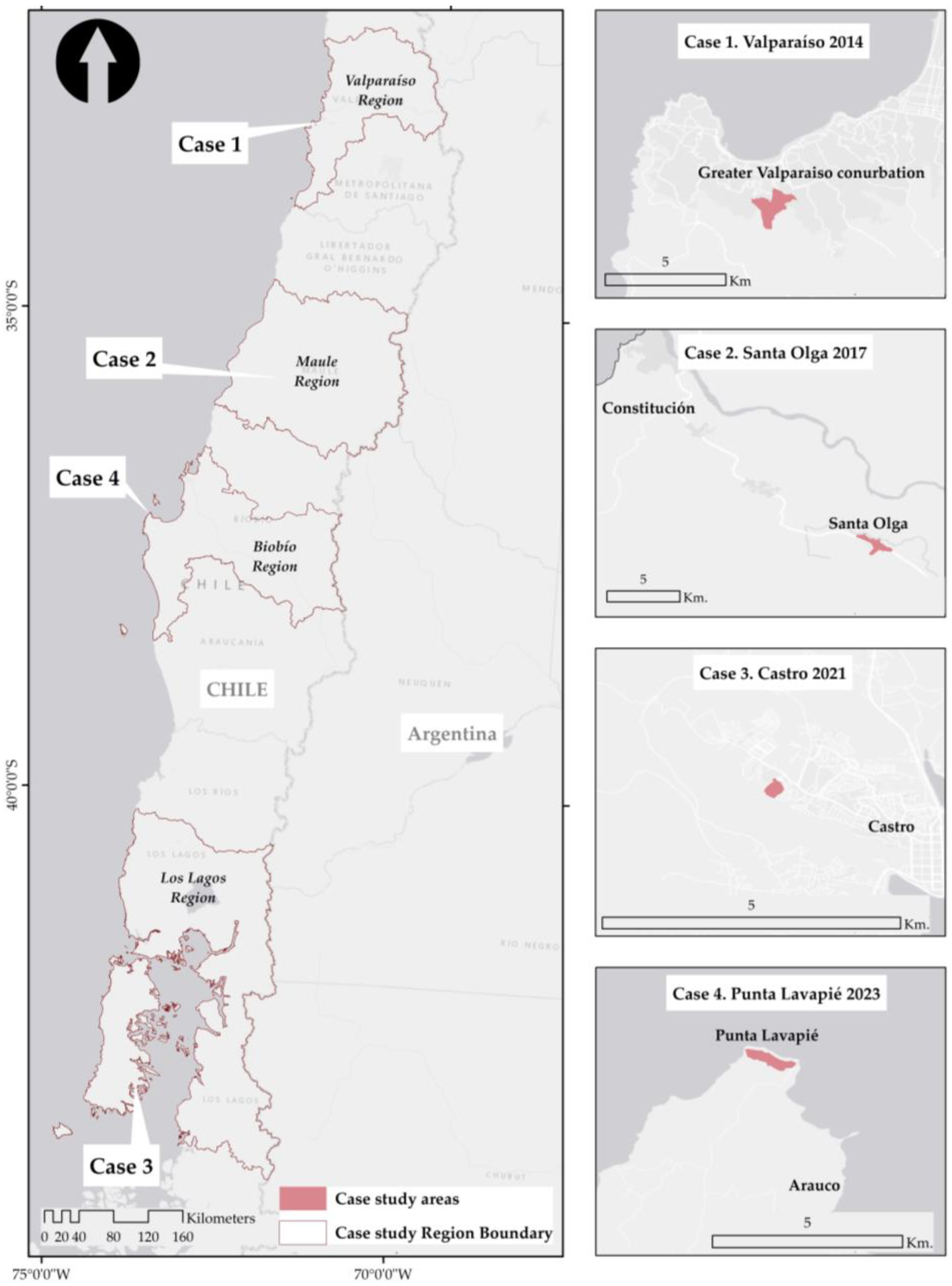
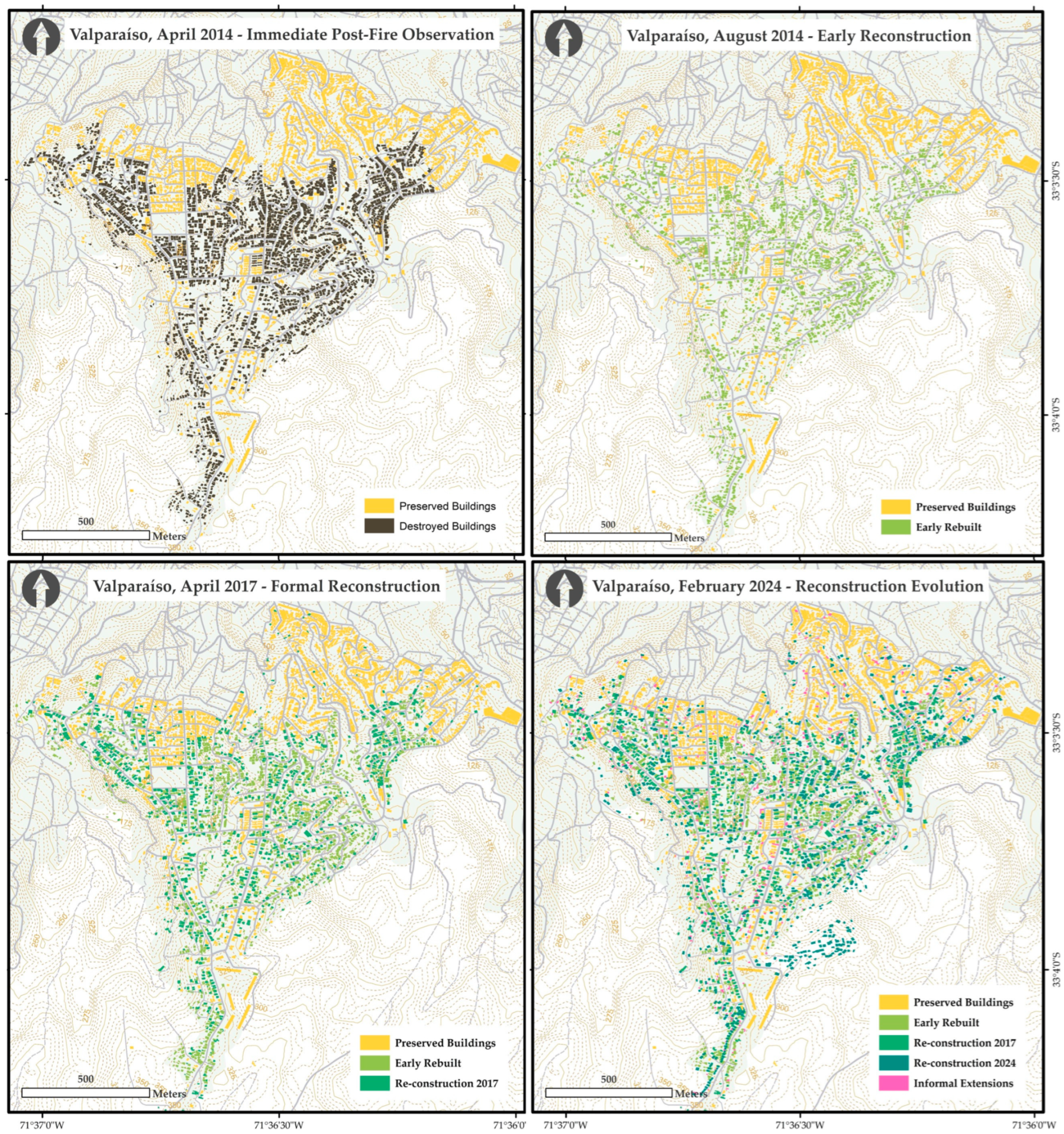
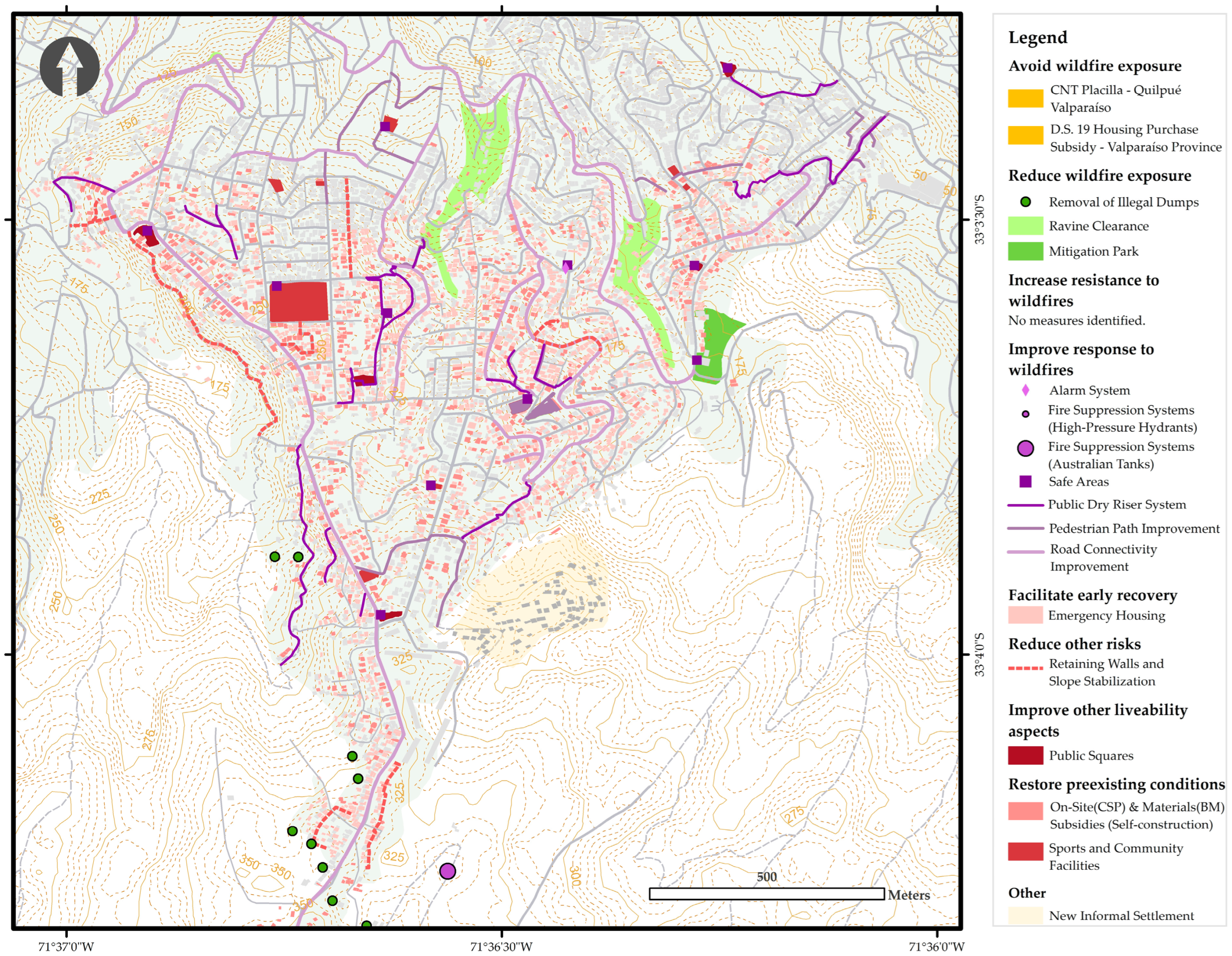
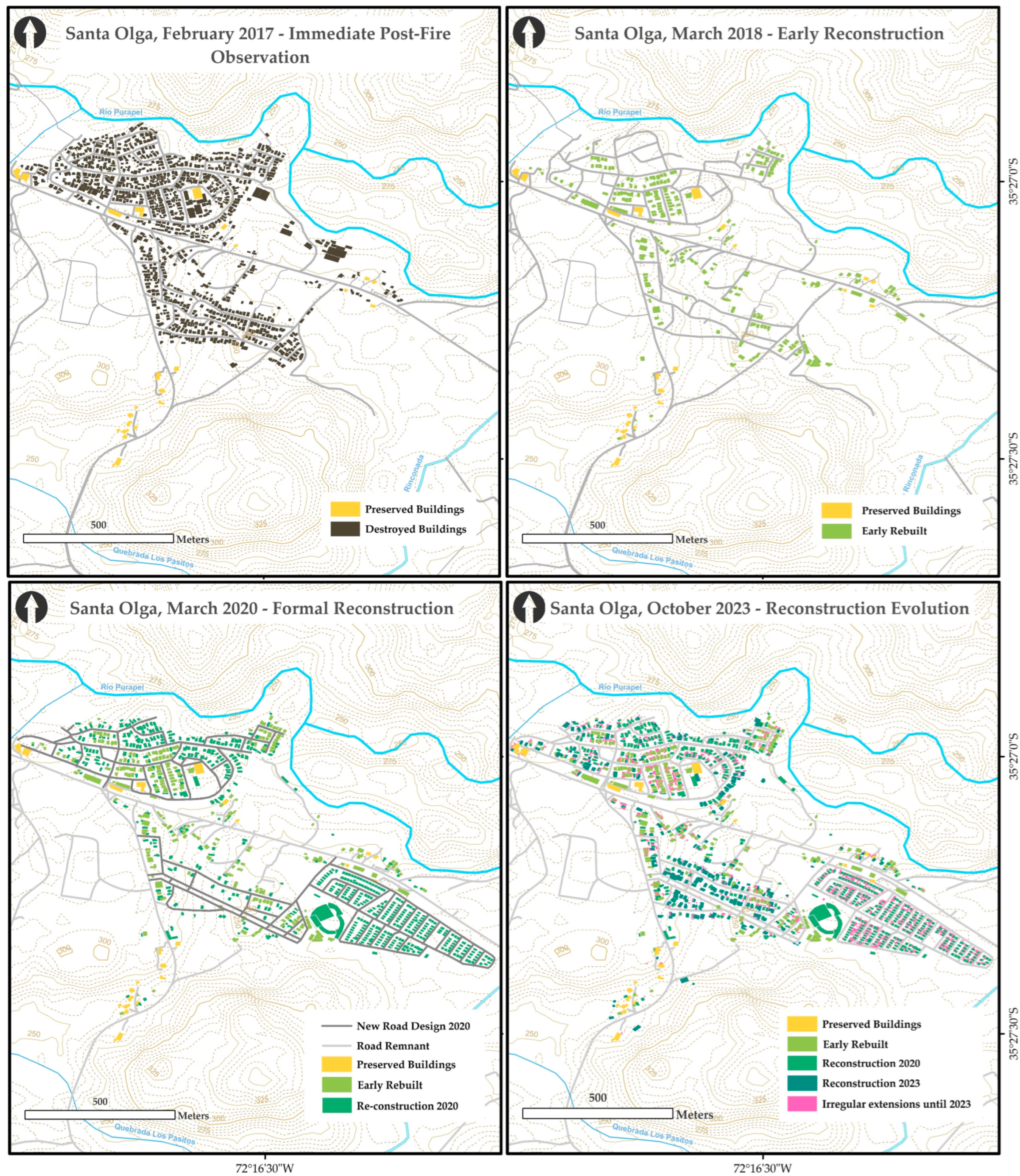
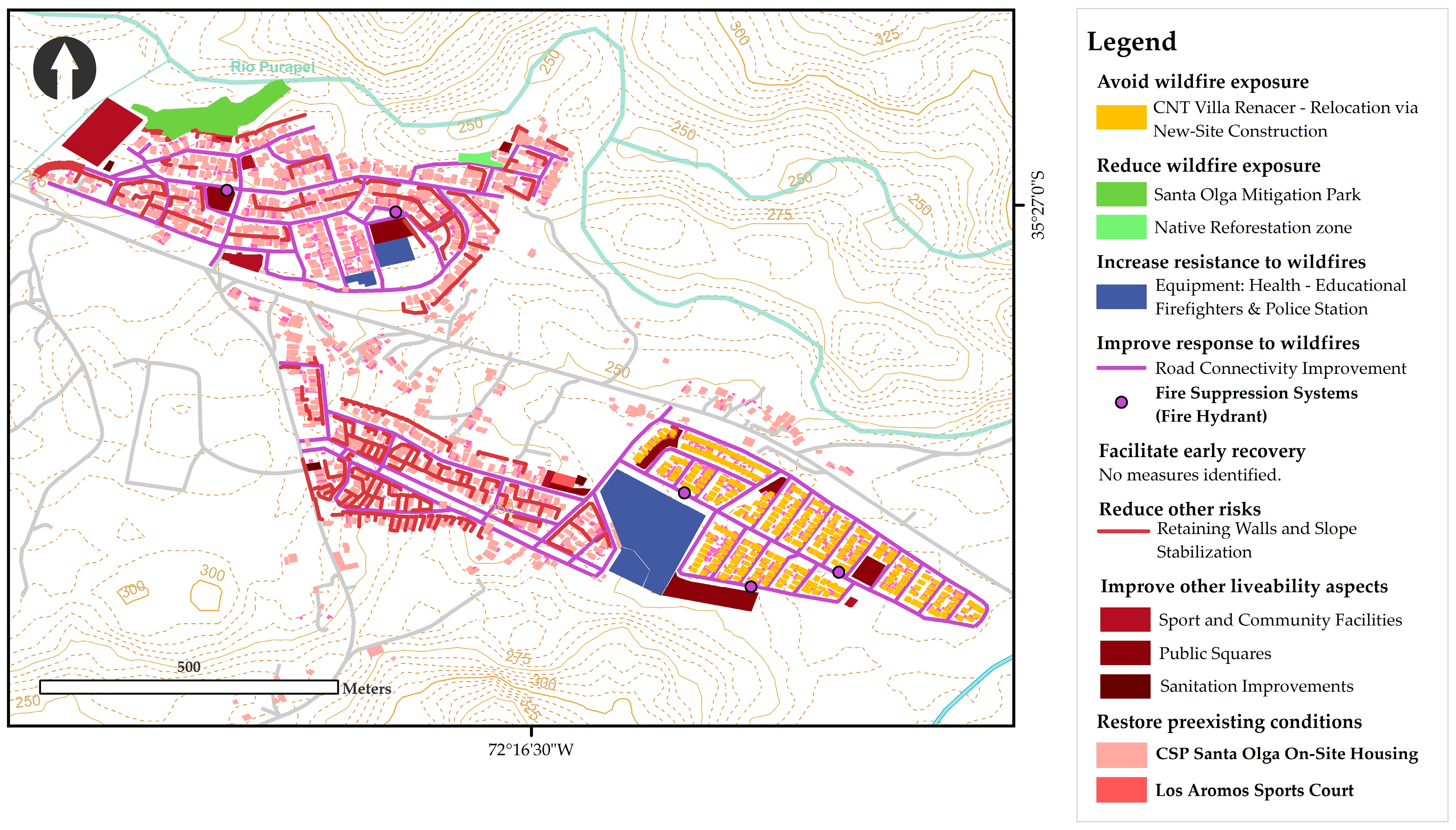
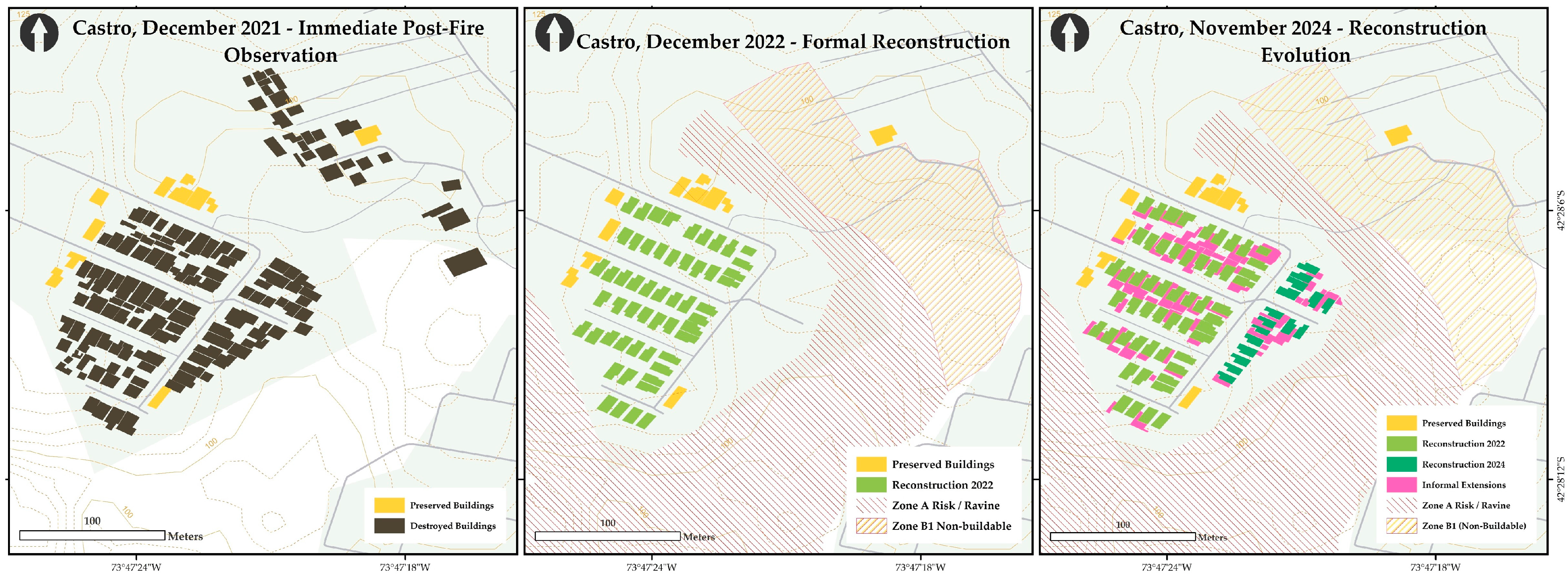
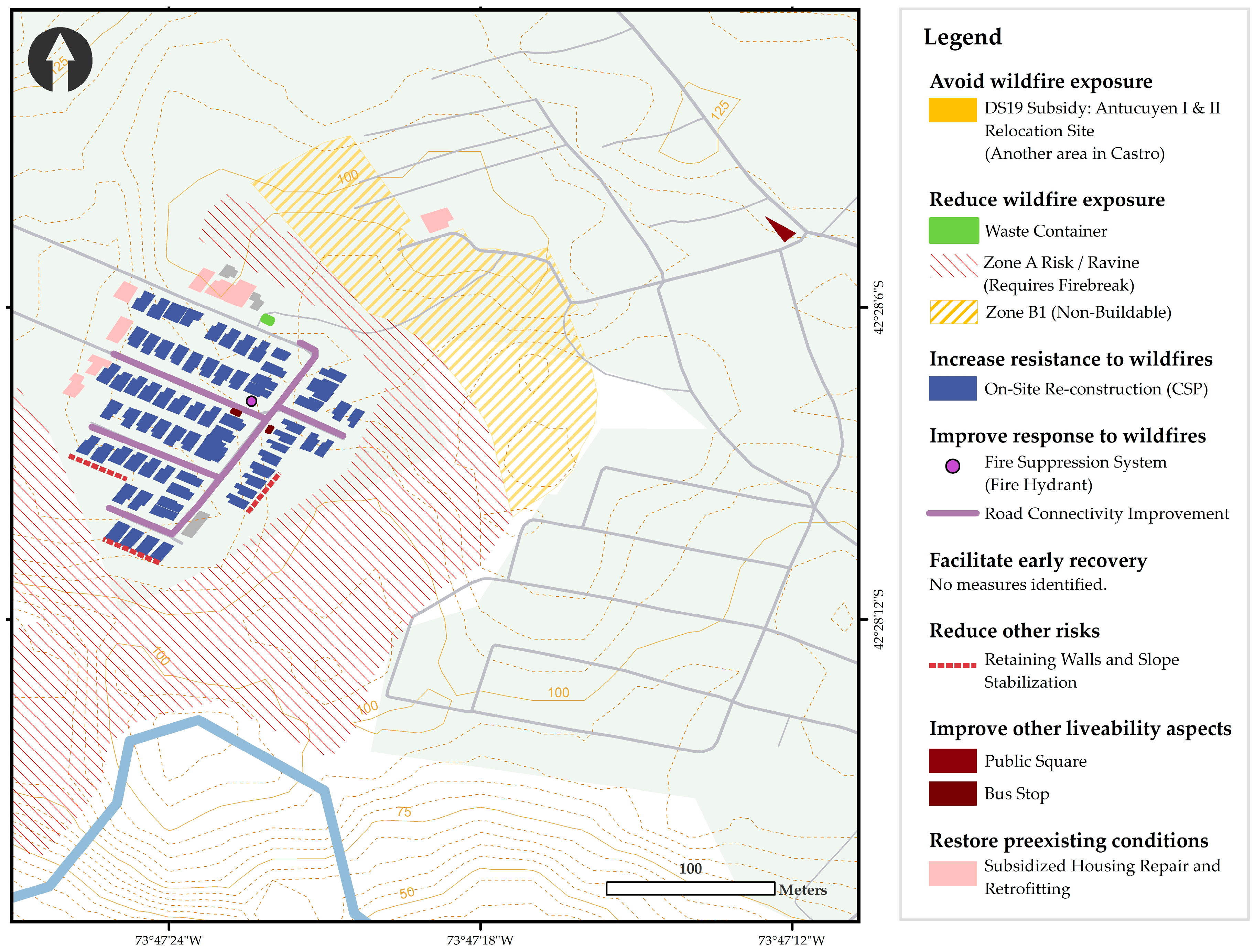
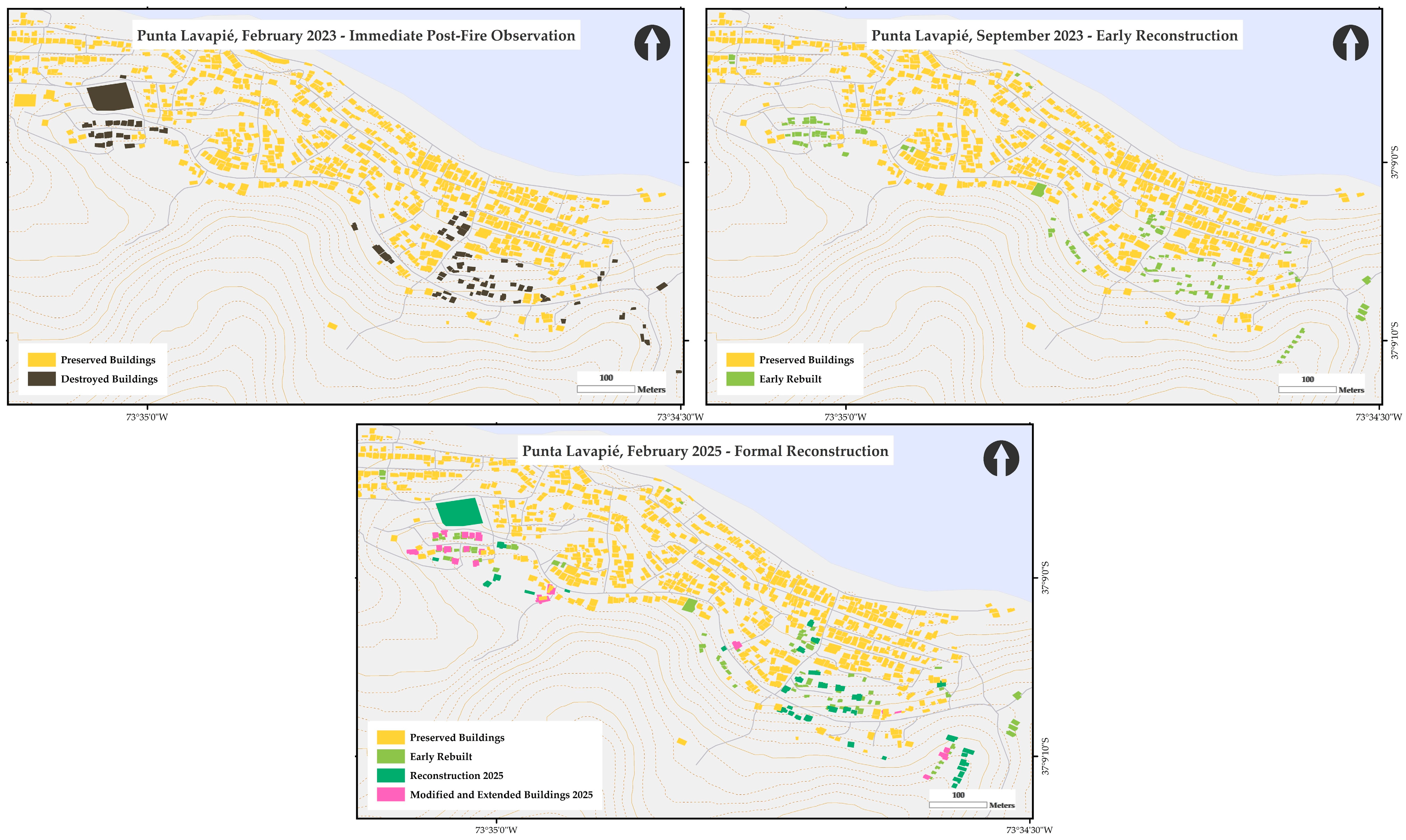
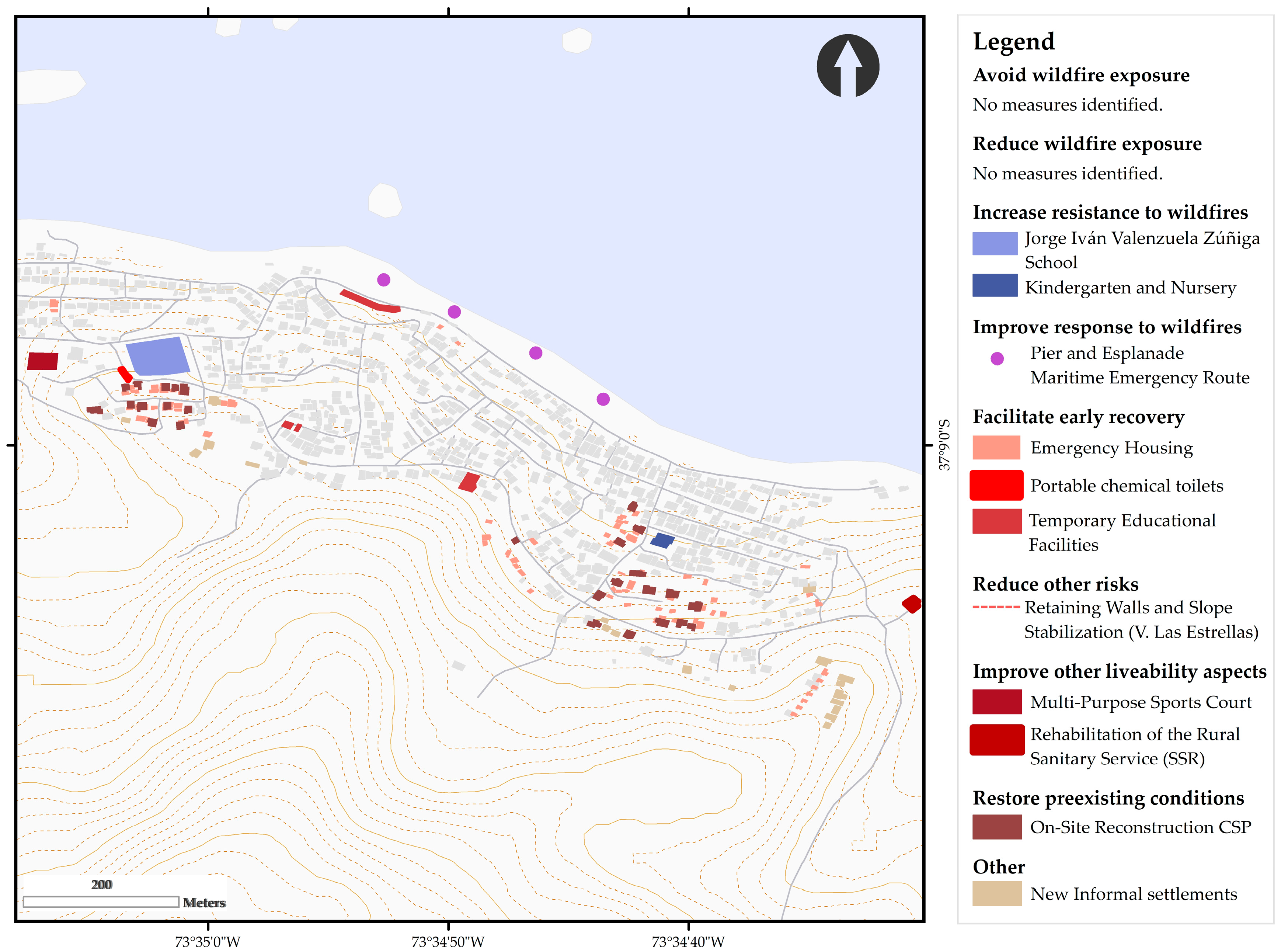
| Case Study | Fire Event Context | Impact | Key Reconstruction Characteristic |
|---|---|---|---|
| Valparaiso 2014 | Large-scale urban interface fire in an area with high informality. | 3226 Constructions destroyed 15 Fatalities 1042 Burned hectares | Long-term (10-year) organic and resident-led reconstruction process leading to densification. |
| Santa Olga 2017 | Near-total destruction of a town during a national megafire event (“Tormenta de Fuego”). | 2831 Constructions destroyed 11 Fatalities 183,946 Burned hectares | State-led, planned “refounding” of the settlement with a new urban layout and managed relocation. |
| Castro 2021 | High-impact fire in a dense, formal urban neighbourhood. | 129 Constructions destroyed. No fatalities 5.4 Burned hectares | Reconstruction is explicitly governed by a post-disaster, risk-based zoning plan to reduce density. |
| Punta Lavapie 2023 | Destruction in an isolated coastal community during a regional megafire event. | 88 Constructions destroyed. No fatalities 1822 Burned hectares | Recent mixed-model response combining temporary housing, a transitional settlement, and industrialized solutions. |
| Case Study | Pre-Fire Observation | Immediate Post-Fire Observation | Early Reconstruction Observation | Formal Reconstruction Observation | Reconstruction Evolution Observation |
|---|---|---|---|---|---|
| Valparaiso (April 2014) | March 2014 | April 2014 | August 2014 | April 2017 | February 2024 |
| Santa Olga (January 2017) | December 2016 | February 2017 | March 2018 | March 2020 | October 2023 |
| Castro (December 2021) | December 2021 | December 2021 | N/A | December 2022 | November 2024 |
| Punta Lavapie (February 2023) | October 2022 | February 2023 | September 2023 | February 2025 | N/A |
| Valparaiso 2014 | Santa Olga 2017 | Castro 2021 | Punta Lavapie 2023 | |||||
|---|---|---|---|---|---|---|---|---|
| Wildfire DRR | Projects | Budget (USD) | Projects | Budget (USD) | Projects | Budget (USD) | Projects | Budget (USD) |
| Avoid wildfire exposure | 2 | 58,115,163 | 2 | 24,436,510 | 2 | 2,736,703 | 0 | 0 |
| Reduce wildfire exposure | 16 | 16,940,026 | 12 | 130,065 | 2 | 111,074 | 0 | 0 |
| Increase resistance to wildfires | 0 | 0 | 2 | 7,621,354 | 1 | 2,621,973 | 2 | 79,362 |
| Improve response to wildfires | 86 | 151,287,731 | 2 | 6,096,567 | 2 | 22,677 | 1 | 562,717 |
| Wider Measures | ||||||||
| Facilitate early recovery | 1 | 2,314,981 | 0 | 0 | 0 | 0 | 5 | 54,640 |
| Reduce other risks | 62 | 2,927,048 | 2 | 18,004,766 | 1 | N/A | 1 | N/A |
| Improve other liveability aspects | 15 | 1,988,127 | 17 | 14,965,358 | 2 | 22,677 | 3 | 350,469 |
| Restore preexisting conditions | 9 | 52,023,492 | 3 | 18,058,143 | 1 | 17,130 | 3 | 2,277,051 |
| Valparaiso 2014 | Santa Olga 2017 | Castro 2021 | Punta Lavapie 2023 | ||
|---|---|---|---|---|---|
| Wildfire DRR | Avoid wildfire exposure | ||||
| Subsidy for Acquisition of Already Built Housing (AVC) | 1 | 1 | 1 | ||
| Construction on New Land Subsidy (CNT) | 1 | 1 | 1 | ||
| Reduce wildfire exposure | |||||
| Mitigation Park | 3 | 1 | |||
| Removing illegal dumps | 10 | ||||
| Waste Management | 1 | ||||
| Clearing ravines | 2 | ||||
| Vegetation Management | 1 | ||||
| Reforestation | 11 | ||||
| Riks Zone and Non-buildable Zone | 1 | ||||
| Increase resistance to wildfires | |||||
| Fire Station | 1 | ||||
| Educational Establishment | 1 | 2 | |||
| On-site Construction Subsidy (CSP) | 1 | ||||
| Improve response to wildfires | |||||
| Signs and Demarcations | 1 | 1 | |||
| Maritime/Port Connectivity Improvement | 1 | ||||
| Road Connectivity Improvement | 10 | 2 | |||
| Pedestrian Path Improvement | 18 | ||||
| Alarm and Siren Systems | 9 | ||||
| Fire Extinguishing Systems | 39 | 1 | |||
| Safe Zones | 9 | ||||
| Wider Measures | Facilitate early recovery | ||||
| Temporary Public Restrooms | 1 | ||||
| Primary School | 1 | ||||
| Kinder garden | 1 | ||||
| Playgroup | 1 | ||||
| Emergency Housing | 1 | 1 | |||
| Reduce other risks | |||||
| Land Containment and Security | 62 | 2 | 1 | 1 | |
| Improve other liveability aspects | |||||
| Sport Facilities | 2 | 1 | 1 | ||
| Medical Centre | 1 | ||||
| Community Spaces | 7 | ||||
| Sanitary improvements | 10 | 2 | 2 | ||
| Murals | 1 | ||||
| Bus Stop | 1 | ||||
| Square | 3 | 4 | 1 | ||
| Bus Station | 1 | ||||
| Restore preexisting conditions | |||||
| Sports Facilities | 3 | 1 | |||
| Community Spaces | 4 | ||||
| Material Bank Subsidy (BM) | 1 | 1 | 1 | 1 | |
| On-site Construction Subsidy (CSP) | 1 | 1 | 2 |
| Valparaiso 2014 | Santa Olga 2017 | Castro 2021 | Punta Lavapie 2023 | ||||||||
|---|---|---|---|---|---|---|---|---|---|---|---|
| Houses: Total Damage | 2516 | 1122 | 129 | 58 | |||||||
| Houses: Unaffected structures | 1757 | 34 | 11 | 8 | |||||||
| Emergency housing | 1600 | 0 | 0 | 75 | |||||||
| On-site Construction Subsidy (CSP) | 1184 | 527 | 67 | 31 | |||||||
| Construction on New Land Subsidy (CNT) | 617 | 270 | 5 | 0 | |||||||
| Subsidy for the Acquisition of Already Built Housing (AVC) | 1087 | 322 | 56 | 0 | |||||||
| Material Bank Subsidy (BM) | 21 | 37 | 7 | 12 | |||||||
| Avoid wildfire exposure | Increase resistance to wildfire | Facilitate early recovery | Restore Preexisting conditions | ||||||||
Disclaimer/Publisher’s Note: The statements, opinions and data contained in all publications are solely those of the individual author(s) and contributor(s) and not of MDPI and/or the editor(s). MDPI and/or the editor(s) disclaim responsibility for any injury to people or property resulting from any ideas, methods, instructions or products referred to in the content. |
© 2025 by the authors. Licensee MDPI, Basel, Switzerland. This article is an open access article distributed under the terms and conditions of the Creative Commons Attribution (CC BY) license (https://creativecommons.org/licenses/by/4.0/).
Share and Cite
Gonzalez-Mathiesen, C.; Aravena-Solís, N.; Rosales, C. Reconstruction as an Opportunity to Reduce Risk? Physical Changes Post-Wildfire in Chilean Case Studies. Sustainability 2025, 17, 9162. https://doi.org/10.3390/su17209162
Gonzalez-Mathiesen C, Aravena-Solís N, Rosales C. Reconstruction as an Opportunity to Reduce Risk? Physical Changes Post-Wildfire in Chilean Case Studies. Sustainability. 2025; 17(20):9162. https://doi.org/10.3390/su17209162
Chicago/Turabian StyleGonzalez-Mathiesen, Constanza, Natalia Aravena-Solís, and Catalina Rosales. 2025. "Reconstruction as an Opportunity to Reduce Risk? Physical Changes Post-Wildfire in Chilean Case Studies" Sustainability 17, no. 20: 9162. https://doi.org/10.3390/su17209162
APA StyleGonzalez-Mathiesen, C., Aravena-Solís, N., & Rosales, C. (2025). Reconstruction as an Opportunity to Reduce Risk? Physical Changes Post-Wildfire in Chilean Case Studies. Sustainability, 17(20), 9162. https://doi.org/10.3390/su17209162







